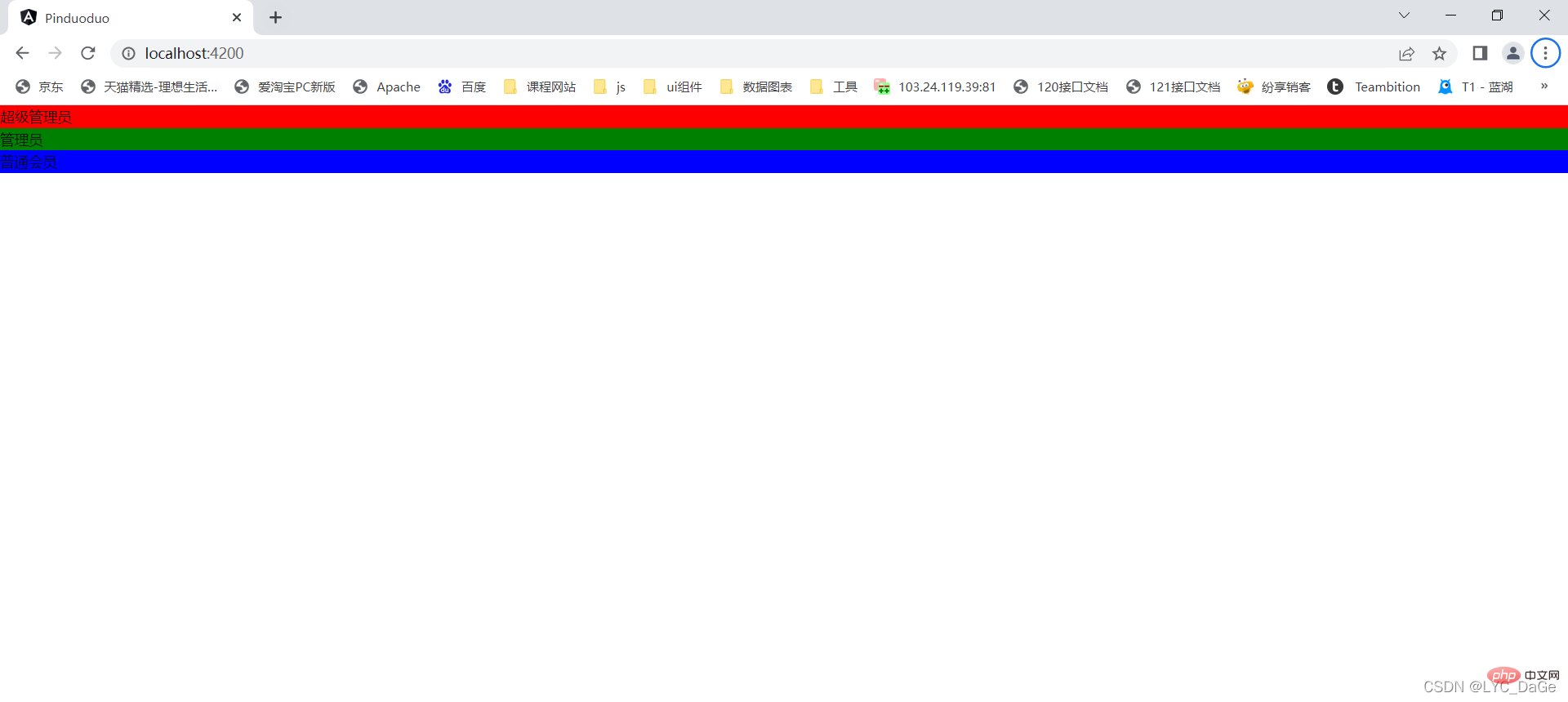 Web Front-end
Web Front-end
 JS Tutorial
JS Tutorial
 A brief analysis of custom structural/attribute directives in Angular
A brief analysis of custom structural/attribute directives in Angular
A brief analysis of custom structural/attribute directives in Angular
Angular instructions are divided into three types, component (with template instructions), structural instructions (changing the host document structure), and attribute instructions (changing the host behavior). The following mainly introduces custom structural instructions and custom attribute instructions. .

1. Custom structural directives
Only one structural directive can be placed on an element , the written form of the structural instruction is * instruction name, * is a syntax sugar, the following code:
<div *ngIf=""></div> <!-- 等价于 --> <ng-template [ngIf]=""> <div></div> </ng-template>
The following is a customized structural instruction. When superadmin and admin are entered into the instruction, the DOM node is displayed, otherwise Remove node. [Related tutorial recommendations: "angular tutorial"]
@Directive({
selector: '[appLogin]'
})
export class LoginDirective implements OnInit{
@Input('appLogin') user=""
constructor(private VCR: ViewContainerRef,private TPL: TemplateRef<any>) {
//在指令的构造函数中将 TemplateRef 和 ViewContainerRef 注入成私有变量。
}
ngOnInit(){
if(this.user=='superadmin'||this.user=="admin"){
this.VCR.createEmbeddedView(this.TPL)
}else{
this.VCR.clear()
}
}
}<div *appLogin="'superadmin'">超级管理员</div> <div *appLogin="'admin'">管理员</div> <div *appLogin="'user'">普通会员</div>
Effect: 
2. Custom attribute instructions
Using attribute directives, you can change the appearance or behavior of DOM elements and Angular components.
1. Import ElementRef from @angular/core. The nativeElement property of ElementRef provides direct access to the host DOM element.
2. Add ElementRef in the directive's constructor() to inject a reference to the host DOM element, which is the target of appColor.
3. Add logic to the ColorDirective class. Under different input conditions, the background will be displayed as red, green, and blue respectively.
@Directive({
selector: '[appColor]'
})
export class ColorDirective implements OnInit{
@Input() appColor=""
constructor(private ele:ElementRef) {
}
ngOnInit(){
if (this.appColor == 'superadmin'){
this.ele.nativeElement.style.backgroundColor="red"
} else if (this.appColor == 'admin') {
this.ele.nativeElement.style.backgroundColor = "green"
}else{
this.ele.nativeElement.style.backgroundColor = "blue"
}
}
}Effect:

For more programming-related knowledge, please visit: Programming Video! !
The above is the detailed content of A brief analysis of custom structural/attribute directives in Angular. For more information, please follow other related articles on the PHP Chinese website!

Hot AI Tools

Undresser.AI Undress
AI-powered app for creating realistic nude photos

AI Clothes Remover
Online AI tool for removing clothes from photos.

Undress AI Tool
Undress images for free

Clothoff.io
AI clothes remover

Video Face Swap
Swap faces in any video effortlessly with our completely free AI face swap tool!

Hot Article

Hot Tools

Notepad++7.3.1
Easy-to-use and free code editor

SublimeText3 Chinese version
Chinese version, very easy to use

Zend Studio 13.0.1
Powerful PHP integrated development environment

Dreamweaver CS6
Visual web development tools

SublimeText3 Mac version
God-level code editing software (SublimeText3)

Hot Topics
 1386
1386
 52
52
 Let's talk about metadata and decorators in Angular
Feb 28, 2022 am 11:10 AM
Let's talk about metadata and decorators in Angular
Feb 28, 2022 am 11:10 AM
This article continues the learning of Angular, takes you to understand the metadata and decorators in Angular, and briefly understands their usage. I hope it will be helpful to everyone!
 Detailed explanation of angular learning state manager NgRx
May 25, 2022 am 11:01 AM
Detailed explanation of angular learning state manager NgRx
May 25, 2022 am 11:01 AM
This article will give you an in-depth understanding of Angular's state manager NgRx and introduce how to use NgRx. I hope it will be helpful to you!
 How to install Angular on Ubuntu 24.04
Mar 23, 2024 pm 12:20 PM
How to install Angular on Ubuntu 24.04
Mar 23, 2024 pm 12:20 PM
Angular.js is a freely accessible JavaScript platform for creating dynamic applications. It allows you to express various aspects of your application quickly and clearly by extending the syntax of HTML as a template language. Angular.js provides a range of tools to help you write, update and test your code. Additionally, it provides many features such as routing and form management. This guide will discuss how to install Angular on Ubuntu24. First, you need to install Node.js. Node.js is a JavaScript running environment based on the ChromeV8 engine that allows you to run JavaScript code on the server side. To be in Ub
 An article exploring server-side rendering (SSR) in Angular
Dec 27, 2022 pm 07:24 PM
An article exploring server-side rendering (SSR) in Angular
Dec 27, 2022 pm 07:24 PM
Do you know Angular Universal? It can help the website provide better SEO support!
 How to use PHP and Angular for front-end development
May 11, 2023 pm 04:04 PM
How to use PHP and Angular for front-end development
May 11, 2023 pm 04:04 PM
With the rapid development of the Internet, front-end development technology is also constantly improving and iterating. PHP and Angular are two technologies widely used in front-end development. PHP is a server-side scripting language that can handle tasks such as processing forms, generating dynamic pages, and managing access permissions. Angular is a JavaScript framework that can be used to develop single-page applications and build componentized web applications. This article will introduce how to use PHP and Angular for front-end development, and how to combine them
 Angular + NG-ZORRO quickly develop a backend system
Apr 21, 2022 am 10:45 AM
Angular + NG-ZORRO quickly develop a backend system
Apr 21, 2022 am 10:45 AM
This article will share with you an Angular practical experience and learn how to quickly develop a backend system using angualr combined with ng-zorro. I hope it will be helpful to everyone!
 A brief analysis of how to use monaco-editor in angular
Oct 17, 2022 pm 08:04 PM
A brief analysis of how to use monaco-editor in angular
Oct 17, 2022 pm 08:04 PM
How to use monaco-editor in angular? The following article records the use of monaco-editor in angular that was used in a recent business. I hope it will be helpful to everyone!
 A brief analysis of independent components in Angular and see how to use them
Jun 23, 2022 pm 03:49 PM
A brief analysis of independent components in Angular and see how to use them
Jun 23, 2022 pm 03:49 PM
This article will take you through the independent components in Angular, how to create an independent component in Angular, and how to import existing modules into the independent component. I hope it will be helpful to you!



